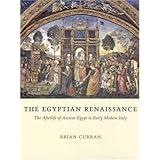
Average Reviews:

(More customer reviews)As a prefatory note, the author of this work assumes the reader has a rudimentary knowledge of Latin, Italian and a history of the renaissance humanist architect/artists of the time such as Vasari, Bramante, Alberti, Bernini & the like. Many referenced book titles go untranslated leaving the reader to guess. This minor encumbrance aside, my only critique would be the writing style. It is lofty, highly scholarly and drags the reader into unrelenting footnotes, many detailing who had access to specific Egyptian artifacts, the provenance of the object & its history within the precincts of Rome, from the Romans who usurped them from Egypt to the numerous times they were moved about & reused by others. The level of detail, however, is astounding & necessary for a complete understanding of these pieces and their role in influencing their revival.
This volume is hardly an account of an Egyptian afterlife understood by the renaissance artists, architects & scholars, but rather what they didn't know. It describes the fanciful "interpretations" of the objects' role in ancient times & accounts of attempting to translate hieroglyphs that were beyond their understanding. Most of the architects of the day proclaimed they understood the ancient language of "Egyptian letters" but few attempted to provide any translations (and those were dismal). Others stated they knew the symbolism of the pyramid & obelisk and therefore were "knowledgeable" in their use. In reality, no one during this period in history truly understood any of the Egyptian monuments extant; only having the writings of inadequate and flawed ancient authors such as Herodotus, Pliny, Horapollo, etc., to assist them. What IS fascinating is the use of these "pagan" symbols by the papacy from Julius II to Leo X & Clement VII. The papal families of Borgia & Colonna both claim a decent from Osiris (Egyptian king of the afterlife) and other Egyptian deities! The apartments and tombs of the popes are littered with frescos & sculptures of these ancient symbols (sphinxes, gold bulls, pyramids, obelisks & folklore) tailored to suit their claim while understanding little of their actual meaning. But, all this rekindled an interest in ancient Egypt.
While there are only 12 color plates and many B & W photos, they beautifully detail the most significant items from the missal of Cardinal Colonna (a Roman Catholic liturgical manuscript laced with Egyptian iconography!) to the granite lions of Nectanebo (a 26th dynasty Nubian pharaoh) currently in the Vatican. This volume gives a rich account of the roots of modern "Egyptomania" and its relevance in art, architecture & literature of the time. There is no "secret knowledge" here, as in fictional novels. Meticulously referenced, overtly so while reading, but from a viewpoint that is refreshingly new, all 430 pages worth!
Click Here to see more reviews about: The Egyptian Renaissance: The Afterlife of Ancient Egypt in Early Modern Italy

0 comments:
Post a Comment